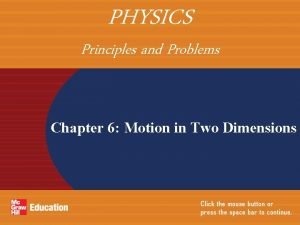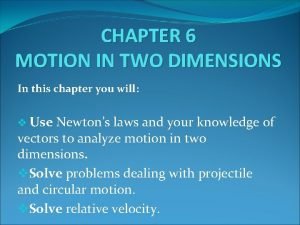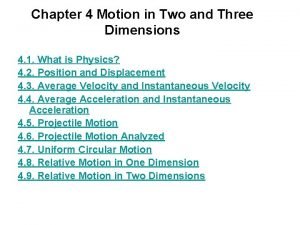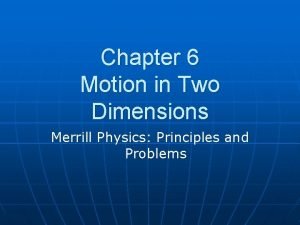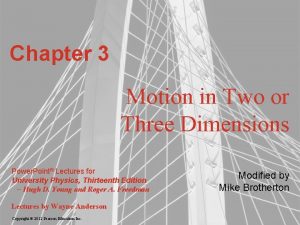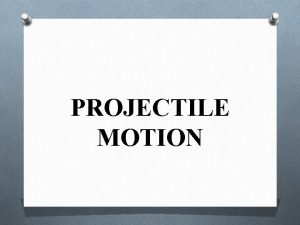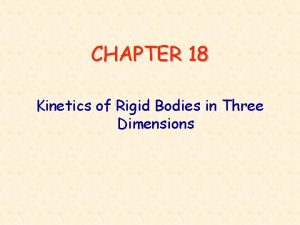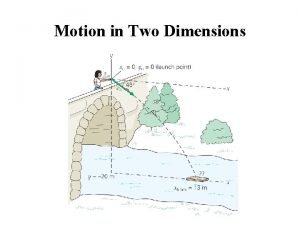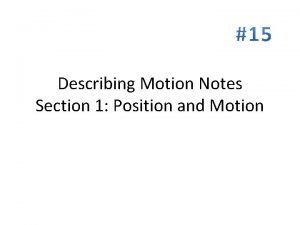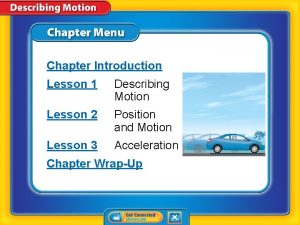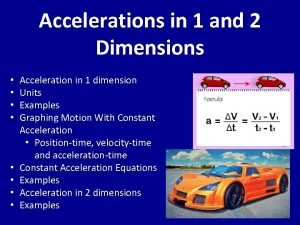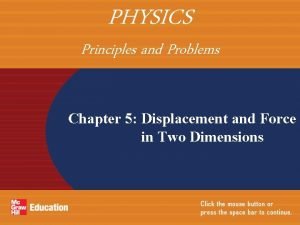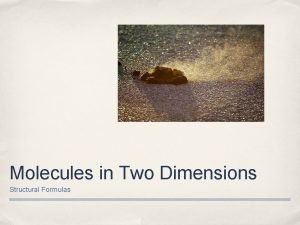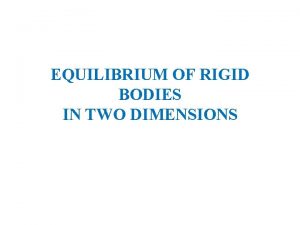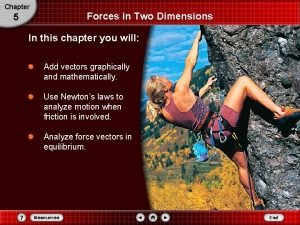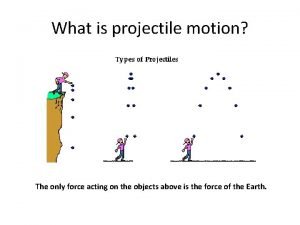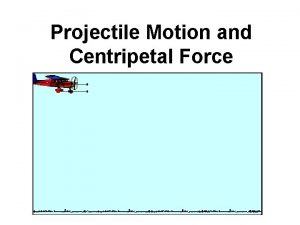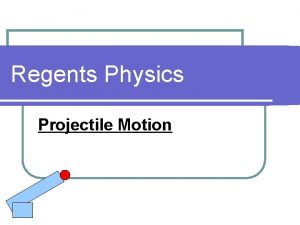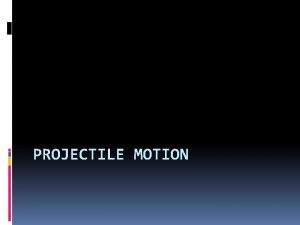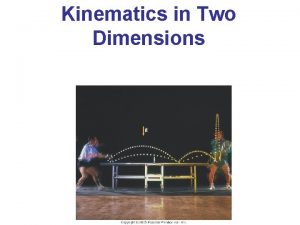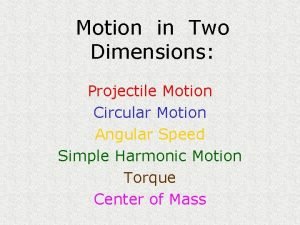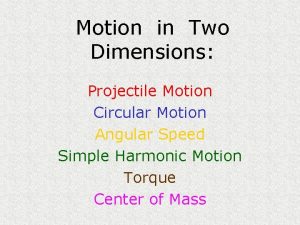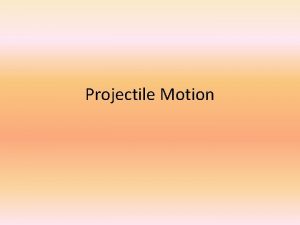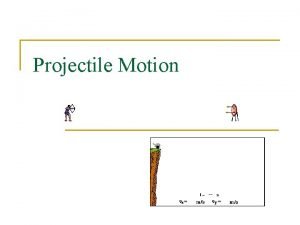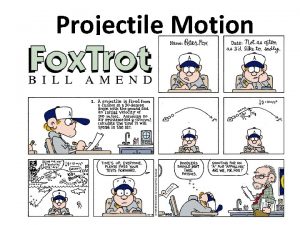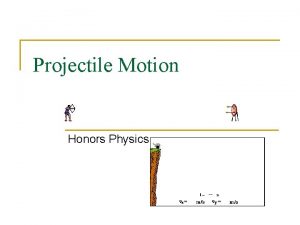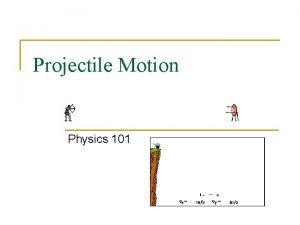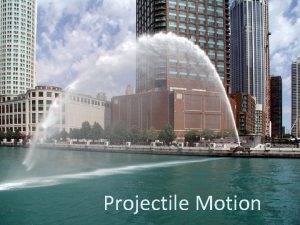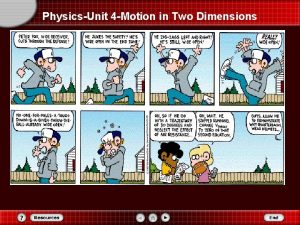Motion in Two Dimensions Projectile Motion A projectile


























- Slides: 26

Motion in Two Dimensions

Projectile Motion A projectile is an object moving in two dimensions under the influence of Earth's gravity; its path is a parabola.

Motion in Two Dimensions

Motion in Two Dimensions ax = 0 ay = -g

Motion in Two Dimensions Ignoring air resistance, the horizontal component of a projectile's acceleration (A) is zero. (B) remains a non-zero constant. (C) continuously increases. (D) continuously decreases.

Motion in Two Dimensions If an object is launched at an initial angle of θ 0 with the horizontal, the analysis is similar except that the initial velocity has a vertical component. q

Motion in Two Dimensions Ignoring air resistance, the horizontal component of a projectile's velocity (A) is zero. (B) remains constant. (C) continuously increases. (D) continuously decreases.

Motion in Two Dimensions y Constant acceleration vo q x Constant velocity Eq 1 Eq 2

Motion in Two Dimensions A ball is thrown with a velocity of 20 m/s at an angle of 60° above the horizontal. What is the horizontal component of its instantaneous velocity at the exact top of its trajectory? (A) 10 m/s (B) 17 m/s (C) 20 m/s (D) zero

Motion in Two Dimensions y Constant velocity vo q x Sub Eq 1 Eq 3

Practice Problem Vx If Vx = 6. 80 units and Vy = -7. 40 units, a) determine the magnitude of V. q Vy V b) determine the direction of V

Motion in Two Dimensions y Constant acceleration vo q x Eq 4

Motion in Two Dimensions A soccer ball is kicked with a velocity of 25 m/s at an angle of 45° above the horizontal. What is the vertical component of its acceleration as it travels along its trajectory? (A) 9. 80 m/s 2 downward (B) (9. 80 m/s 2) × sin (45°) downward (C) (9. 80 m/s 2) × sin (45°) upward (D) (9. 80 m/s 2) upward

Motion in Two Dimensions When a football in a field goal attempt reaches its maximum height, how does its speed compare to its initial speed? (A) It is zero. (B) It is equal to its initial speed. (C) It is greater than its initial speed. (D) It is less than its initial speed.

Motion in Two Dimensions Vertical Position as a Function of Horizontal Displacement y vo q h x Solve Eq 3 for t Sub into Eq 4 Eq 5

Motion in Two Dimensions Maximum Height y vo q h x Sub into Eq 4 At the maximum height (vy = 0) Eq 6 Eq 7

Problem A football is kicked at ground level with a speed of 18. 0 m/s at an angle of 35. 0º to the horizontal. How much later does it hit the ground? Time in the air is twice the time to the top.

Motion in Two Dimensions y Range vo q h x R Eq 8

Motion in Two Dimensions At what angle should a water-gun be aimed in order for the water to land with the greatest horizontal range? (A) 0° (B) 30° (C) 45° (D) 60°

Motion in Two Dimensions The range of a projectile is maximum (if there is no air resistance) for a launch angle of 45°.

Problem A projectile is fired with an initial speed of 65. 2 m/s at an angle of 34. 5º above the horizontal on a long flat firing range. Determine (a) the maximum height reached by the projectile. (b) the total time in the air (c) the total horizontal distance covered (that is, the range).

Question 3. 10 a Shoot the Monkey I You are trying to hit a friend with a water balloon. He is sitting in the window of his dorm room directly across the street. You aim straight at him and shoot. Just when you shoot, he falls out of the window! Does the water balloon hit him? Your friend falls under the influence of gravity, just like the water balloon. Thus, they are both undergoing free fall in the ydirection. Since the slingshot was accurately aimed at the right height, the water balloon will fall exactly as your friend does, and it will hit him!! a) yes, it hits b) maybe—it depends on the speed of the shot c) no, it misses d) the shot is impossible e) not really sure Assume that the shot does have enough speed to reach the dorm across the street.

Shoot the Monkey

Equations Horizontal Velocity Eq 1 Vertical Velocity Eq 2 Horizontal Displacement Eq 3 Vertical Displacement Eq 4

Equations Vertical Position Eq 5 Time to the Top Eq 6 Maximum Height Eq 7 Range Eq 8

 Physics principles and problems chapter 6 answers
Physics principles and problems chapter 6 answers Chapter 6 study guide motion in two dimensions
Chapter 6 study guide motion in two dimensions Chapter 6 motion in two dimensions
Chapter 6 motion in two dimensions Motion in two and three dimensions
Motion in two and three dimensions Chapter 6 motion in two dimensions
Chapter 6 motion in two dimensions Motion in two or three dimensions
Motion in two or three dimensions Vectors quick check
Vectors quick check Motion in two dimensions quick check
Motion in two dimensions quick check What are two components of projectile motion
What are two components of projectile motion Define projectile motion in physics
Define projectile motion in physics Kinetics of rigid bodies
Kinetics of rigid bodies Vy=gt
Vy=gt Two dimensions of political ideologies
Two dimensions of political ideologies Projectile motion displacement formula
Projectile motion displacement formula Describing motion section 1
Describing motion section 1 Chapter 1 lesson 2 describing motion answer key
Chapter 1 lesson 2 describing motion answer key Dimension of acceleration
Dimension of acceleration Two dimensions of media
Two dimensions of media Chapter 5 displacement and force in two dimensions
Chapter 5 displacement and force in two dimensions Molecules in two dimensions structural formulas
Molecules in two dimensions structural formulas Equilibrium of rigid bodies in two dimensions
Equilibrium of rigid bodies in two dimensions What are the two external dimensions of the space matrix?
What are the two external dimensions of the space matrix? Chapter 5 forces in two dimensions worksheet answers
Chapter 5 forces in two dimensions worksheet answers Fountain model in software engineering
Fountain model in software engineering 256 x 1024
256 x 1024 The only force acting in a horizontal projectile motion is
The only force acting in a horizontal projectile motion is Symmetrical projectile motion
Symmetrical projectile motion
